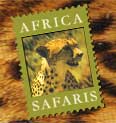|
>
|
GUIDED SAFARIS IN NAMIBIA
|
About Namibia: Namibia may have been called "the land God made in anger" by the ancient San tribes, but it is home to quaint coastal towns, tribal villages and the 80-million-year-old Namib Desert - a magical and captivating destination. The stark desert landscape has drawn thousands of photographers to Namibia however it yet to be discovered by the mass tourism of Eastern & South Africa. The appeal of Namibia lies in the magical desert atmosphere, the game-rich Etosha National Park, charming Swakopmund and the magical Nambi-Naukluft Park. The memories of your trip to Namibia and the vision of it's stark beauty will remain etched in your mind forever...
• World's oldest desert - the Namib Desert
• Impressive Fish River Canyon
• Stunning Big Five game parks with rare species of wildlife
• 1 500-year-old Welwitschia Mirabilis plant
Guided Safaris in Namibia:
Namibia's Safari Attractions:
NAMIB-NAUKLUFT PARK
This is the largest conservation area in Namibia, measuring almost 50 000km² and incorporating most of the 80-million-year-old Namib Desert after which Namibia takes its name. This is a land of ethereal landscapes and endless horizons. Sun-bronzed and untamed, it is a place of silence and of solitude. A climb to the top of one of the gigantic sand dunes surrounding Sossusvlei to watch the sunset slowly cast its shadows over the ancient sea of surrounding dunes is a haunting sight. It will be etched in your mind forever. Near Sossusvlei, the Sesriem Canyon has been gouged out of rock over the centuries by the Tsauchab River and is now mostly small pools of water on a gravel bed, attracting many birds and animals. To the far south of the park near Lüderitz, one can explore the deserted houses in the ghost town of Kolmanskop. To the west at Swakopmund, one can marvel at the fantastic rock formations of the “Moon Landscape” and visit Sandwich Harbour, where the sand dunes meet the sea.
SKELETON COAST
The southern section of the Skeleton Coast Park, which is accessible to the general public, lies between the Ugab and Hoanib Rivers and lures anglers from far and wide to its superb fishing grounds. This is, however, closely monitored by the Ministry of Environment and Tourism. Access to the protected northern area of this park, where the coastline is dotted with forgotten shipwrecks, is restricted to fly-in safaris.
ETOSHA NATIONAL PARK
This is one of the greatest and most special game parks in Africa, if not the world. This is because of the great variety of game and unique vegetation to be found here. The park covers 22 270 km² of land ranging from dense bush to open plains. In the heart of the park is the vast Etosha Pan (“the place of dry water”). The pan is parched and shimmering silver-white for most of the year, only filling with water about a metre deep in very rainy periods – whereupon enormous numbers of water fowl flock to breed. Game in Etosha includes several rare and endangered species such as black rhino and black-faced impala.
DAMARALAND
The northern areas of Damaraland feature some of Namibia’s least explored and rugged remote areas. Here, in one of the few remaining untouched wilderness areas of Africa, it is easy to see why the San (Bushman) people call Namibia “the land God made in anger”. The emphasis is on the spectacular scenery, dominated by massive flat-topped mountains and crystal blue skies; the uniquely adapted smaller desert creatures and plants; the peace and tranquillity of being in such a remote area; and if you are extremely lucky, catching sight of the desert-dwelling elephant and black rhino that roam the area. Southern Damaraland offers such unique curiosities as the mystery of the Petrified Forest; the incredible collection of San rock engravings at Twyfelfontein; the massive Vingerklip (Finger Rock); the Burnt Mountain of volcanic rock and the nearby formation of perpendicular basalt called the Organ Pipes.
|









